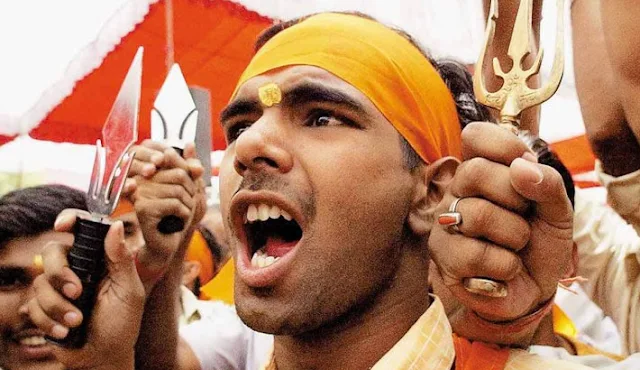A human right, not just a constitutional right but, an universal moral limit on the government’s power and also an universal moral reason for the government to ensure the sustainability of pluralism and diversity within the society. If Government can't, then who can.
By IndraStra Global Editorial Team
Religious liberty
flows from who we are, not from the fickle will of the state. The universality
of liberty must be grounded not in things that change, but in things that don’t
change. Universal human truth.
Religious defamation laws require the state
to decide what is true and what is not.
- Defamation is itself a legal mechanism by which truth-seeking is
essential.
- Defamation of religion requires no fact-finding, it requires
moderation of ideas, thus requiring the state to determine which ideas are
acceptable and which are not.
Why are defamation of religion laws/
anti-blasphemy laws only exercised upon minority faiths, wherever they
are?
Defamation
of religion laws / anti-blasphemy
laws always suffer religious minorities and dissenters.
- In India, Hindu majority, Christian, Muslim minority.
- In Sri Lanka, Buddhist majority, Christian, Muslim, Hindu minority.
- In Pakistan, Egyptian majority, Christian, Baha’i minority.
- In Turkey, secular majority, practicing Muslim, Christian/Orthodox
minority.
Defamation
of religion laws are distinct from other defamation laws because they do not
protect persons, good faith speech, or dissent.
Religious
defamation laws do not protect the truth. Unlike with regular defamation laws,
the “truth is not a defense,” as in the case of Pastors Daniel
Scot and Danny Nalliah in Victoria, Australia.
At 4th
session of Human Rights Council in 2007. Sudan stated the Danish cartoons lead
to a “wave of anger among Muslims” as evidence of how failure to guard against
religious defamation engenders human rights abuses. That is notably
different from the cartoons leading to a wave of anger against Muslims.
Being lead to feel anger is not a human rights abuse.
There’s a
fundamental viewpoint disagreement regarding whether religious intolerance is
the right of private citizens. For Example: Nazis marching in Peoria; Satanists advocating child sacrifice;
Christians who say that Hinduism is idolatry; Muslims who believe that Jesus is
not the Son of God, Hindus who says Muslims are propagating beef consumption.
We would
act in the first two instances against the underlying action being advocated –
against fascism, against child sacrifice. In the last two, the underlying
action is the idea itself. So defamation of religion laws don’t protect
against danger; they protect people from hearing ideas they don’t like.
Implementation of a typical National Anti - Vilification Policy in India:
To overcome such instances, country like
India need to discourage all kind of acts leading to vilification of one's
religion, race, creed, belief and sexual orientation through a collection of
omni present laws and deploying them effectively through out the land till the
jurisdiction limits it.
First
Step, classify the types
of vilification: Religious Vilification (Hindus and Muslim Divide), Racial
Vilification (North and South India Divide), Language Vilification (Maharashtra
and North India Divide), Women's Right Vilification , Sexual Orientation
Vilification, Terminal Disease Based Vilification (HIV AIDS Cases)
Second
Step, Collect all the existing
laws under single basket and term it "National Anti - Vilification Policy
(NAVP)". Wherever, an amendment is required like in the case of
homosexuality practices, a crime under IPC 377 should be discussed within the
political quarters, seek out a people's referendum if it's required, and then
should be added into NAVP with mass consensus only.
Third
Step, train the law
enforcement agencies and legal fraternity across the nation to adopt and adapt
NAVP into their day to day duties.
Fourth
Step, implement NAVP Compliance Certification
System at the work places, both public and private. Ensure a yearly audit of
the firms. If a certain number of complains are received from
one particular organization in a one financial year, initiate probe and
enforce tax penalty based upon the findings. Also, direct the organization to
bear the cost of staff re-education on NAVP subjects.
Fifth
Step, consider any
document provided by complainant on any act of vilification occurred on
Internet, chat rooms, VoIP, social media platforms as a valid proof
to initiate investigation against the vilifier under statutory IPC
codes. To have more effective monitoring and greater control, all foreign
social media sites with maximum number of Indian citizen's data should be
directed to install their data servers in Indian soil, complying with Indian
laws.
Sixth
Step, once investigation
is done and if the guilt has been proved under Civil Provision or Criminal
Provision, link the vilifier's record to his/her Aadhar ID Verification Portal
(https://resident.uidai.net.in/aadhaarverification). And, make it available to
those as NAVP Records in the form YES/NO, whenever certain verification queries
are raised by any prospective employers at the terminal.
Seventh
Step, to make sure all
above "Six Steps" work in tandem, implement Uniform Civil Code and
abolish all personal laws based on the scriptures and customs
of each major religious community in the country with a common set governing
every citizen. Period!
The
Possible Argument:
The argument that proof of intention to
incite an hatred ought to be a requirement for securing a conviction under the
criminal provisions derives from the common law concept that the element of mens
rea (literally “guilty mind”) must be present to justify the
imposition of criminal sanctions. Satisfying this requirement in any criminal
prosecution usually entails proof of criminal intent or at least reckless
indifference by the accused to the consequences of the proscribed
behavior.
The counter-argument is that public acts of
vilification on any of the prohibited grounds ought to be criminalize whether
or not there is intent or recklessness, because of the destructive message that
would be conveyed to society if those acts went unpunished.
One possible way of dealing with the mens
rea element would be to introduce two types of offence to proscribe
vilificatory behaviour. The first offence would require proof of an intention
to incite hatred and would carry the heavier penalty. The second offence would
be in the nature of a strict liability offence and would require proof only of
the likelihood (or reasonable likelihood) of a proscribed outcome. A person
charged with the first offence could, if intention is not proved, be liable
nevertheless to be convicted of the second offence, if the evidence is
sufficient to prove the elements of the second offence
When question of defence comes into picture, one has to be clear about Indian Penal Codes i.e., liability offense codes are framed in
identical terms to the criminal offences but without the element of intent. If
the proscribed conduct is merely “likely” to incite racial animosity or racist
harassment or to result in racist harassment, the offence in each case will be
proved. The word “likely” is usually associated with the civil standard of
proof, and its appearance in a criminal statute might be considered anomalous.
Further, there are defences that
are available to a person accused of committing any of the strict liability offences, which are not available to
persons accused of the intentional offences. In essence, these defences excuse conduct that is
done “reasonably and in good faith” if the conduct was either a fair report of
a public act, or a communication in respect of which a defence of absolute
privilege would apply in defamation proceedings or a public act, done
reasonably and in good faith, for academic, artistic, scientific or research
purposes or for other purposes in the public interest, including discussion or
debate about and expositions of any act or matter. The availability of these
defences can provide an accused person with the opportunity of using the
proceedings to grand-stand and repeat the vilificatory conduct in the
court-room with impunity.
Conclusion:
A human right, not just a constitutional right but, an universal moral limit on the government’s power and also an universal moral reason for the government to ensure the sustainability of pluralism and diversity within the society. If Government can't, then who can.
AIDN: 001-12-2015-500




















